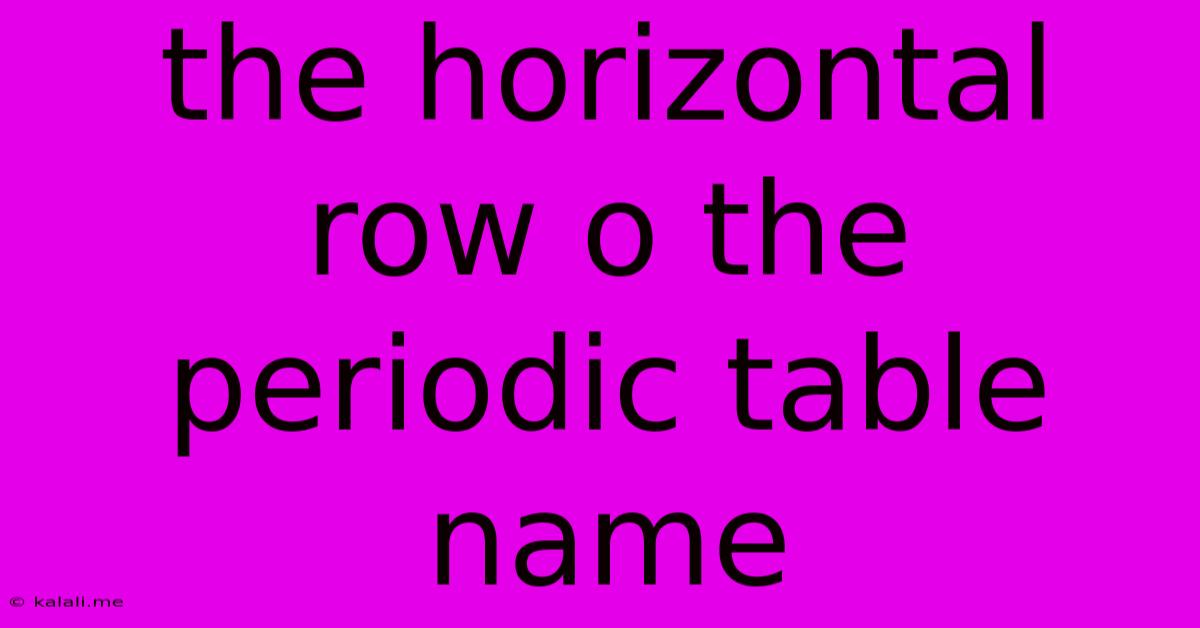The Horizontal Row O The Periodic Table Name
Kalali
Jun 13, 2025 · 3 min read

Table of Contents
Understanding the Horizontal Rows of the Periodic Table: Periods and Their Significance
The periodic table, a cornerstone of chemistry, organizes elements based on their atomic structure and properties. While columns (groups) represent elements with similar chemical characteristics, the horizontal rows, known as periods, showcase a different aspect: the gradual increase in atomic number and the resulting changes in electron shell configuration. This article delves into the significance of periods in the periodic table and explores the trends observed across each row. Understanding periods is crucial for grasping the fundamental principles of atomic structure and predicting element behavior.
Understanding the arrangement of elements across periods reveals systematic changes in their properties. The number of electron shells increases as you move down the table, resulting in distinct properties for elements within each period.
What are Periods in the Periodic Table?
Periods are the horizontal rows in the periodic table. Each period corresponds to the principal quantum number (n) of the outermost electron shell. The first period contains only two elements, hydrogen (H) and helium (He), because the first electron shell can only hold a maximum of two electrons. Subsequent periods accommodate more elements due to the increasing capacity of electron shells. For instance, the second period contains eight elements (lithium to neon), reflecting the filling of the second electron shell.
Trends Across Periods: A Systematic Change
Moving from left to right across a period, several key trends are observed:
-
Atomic Radius: Atomic radius generally decreases across a period. This is because the number of protons in the nucleus increases, attracting the electrons more strongly and pulling them closer to the nucleus.
-
Ionization Energy: Ionization energy, the energy required to remove an electron from an atom, generally increases across a period. The increasing nuclear charge makes it more difficult to remove an electron.
-
Electron Affinity: Electron affinity, the energy change when an atom gains an electron, generally increases across a period (with some exceptions). The increasing nuclear charge attracts additional electrons more strongly.
-
Electronegativity: Electronegativity, the ability of an atom to attract electrons in a chemical bond, generally increases across a period. This is a consequence of the increasing nuclear charge and decreasing atomic radius.
-
Metallic Character: Metallic character, the tendency of an element to lose electrons and form positive ions, generally decreases across a period. Elements on the left side of a period are typically metals, while those on the right are non-metals. This transition reflects the changing electron configurations and bonding characteristics.
The Significance of Periodicity
The periodic arrangement of elements within periods isn't arbitrary. The repeating patterns of properties, a phenomenon known as periodicity, allows chemists to predict the properties of elements based on their position in the table. This predictability is crucial for understanding chemical reactions and synthesizing new compounds.
Periods and Electron Configurations
The electron configuration of an element determines its chemical behavior. The period number corresponds to the highest principal quantum number (n) of the electrons in the element's ground state configuration. Understanding the filling of electron subshells (s, p, d, and f) within each period helps explain the observed trends in properties. For example, the filling of the p-subshell across periods 2 and 3 accounts for the transition from metals to nonmetals.
Conclusion
The horizontal rows of the periodic table, the periods, provide a crucial framework for understanding the systematic variation in properties of elements. By analyzing the trends across periods – changes in atomic radius, ionization energy, electron affinity, electronegativity, and metallic character – we gain insights into the fundamental principles governing atomic structure and chemical reactivity. This understanding forms the bedrock of chemical prediction and the design of new materials.
Latest Posts
Latest Posts
-
Which Of The Following Statements Are True Regarding Explicit Memory
Jun 14, 2025
-
Which One Of The Following Statements Is Incorrect
Jun 14, 2025
-
Which Of The Following Is Not An Agent Of Socialization
Jun 14, 2025
-
Common Factors Of 56 And 84
Jun 14, 2025
-
Lcm Of 9 6 And 3
Jun 14, 2025
Related Post
Thank you for visiting our website which covers about The Horizontal Row O The Periodic Table Name . We hope the information provided has been useful to you. Feel free to contact us if you have any questions or need further assistance. See you next time and don't miss to bookmark.